Phonics instruction (or word study, or word work) is an important component of literacy instruction.
But as you probably already know, it’s such a complex thing to teach! Questions come up, like…
- How do you figure out what kids need to work on?
- What’s the best way to address different students’ levels?
- How do you differentiate when your students are at SO many different levels?
- Which activities are most effective for getting kids to actually REMEMBER words and word patterns?
- How can you keep activities fresh without spending every waking moment making materials?!
It’s a lot to think about!
Over the next weeks and months, I’ll try to address all of these questions and more – through blog posts, videos, resources, and webinars.
I thought that a good starting point would be to share some general best practices for teaching phonics or word study. Understanding these concepts will help you make sense of the blog posts and freebies that I’ll share with you over the following weeks!
My goal was to take a lot of information and synthesize it into a format that is (hopefully) easy-to-understand and applicable!
But before we dive in, a couple of Q and As! 🙂
What grade levels is this appropriate for?
Most of my own teaching experience is in K-2, so these are the grade levels that this post focuses on. These same principles apply to the older elementary grades, however.
What resources did you use to write this post?
I used parts of Best Practices in Literacy Instruction (Morrow & Gambrell), Words Their Way (Bear, Invernizzi, Templeton, & Johnston), Rethinking Phonics (Dahl, Scharer, Lawson, & Grogan), A Fresh Look at Phonics, Grades K-2 (Blevins), and several different articles from the Reading Teacher journal. You can check out my bibliography at the end if you’re interested in learning more!
Should I change my instruction if it doesn’t reflect these best practices?
Research indicates that following these best practices will lead to improved student outcomes – so making changes will be helpful to your students!
At the same time, keep in mind that the research I’ve included here doesn’t tell the whole story. Any research can be biased or flawed. Studies can contradict each other. Sometimes there’s a gap between research and actual classroom practice.
That said, I’ve done my best to gather resources that are trustworthy and peer-reviewed. I’ve used the principles in this post in my own teaching, and I’ve seen that they work.
I hope that this information will be helpful to you!
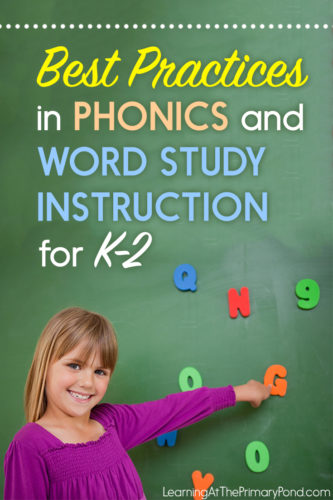
Photo Credits; wavebreakmedia, Shutterstock
Principle #1: There is no one best way to teach phonics. But however you teach it, phonics instruction should be systematic and explicit.
- Systematic means that we progress through a specific scope and sequence. For example, if students are ready to learn short vowel word families, we don’t teach miscellaneous word families as they appear in our shared reading stories. We have a plan to teach the -at word family, then -an, etc. It also means that instruction goes from easy to complex and includes built-in review and repetition (Blevins, 2017).
- Explicit means that we have to directly teach students about letters, words, and spelling patterns. We use thinkalouds and clear language so that students gain strategies for reading and writing words. Although we can encourage students to make their own discoveries about words, we don’t expect them to do it on their own.
- Word work can’t simply be assigned as independent work. Although independent practice is important, the instruction you provide students is essential: “Word study…offers valuable opportunities for students to be actively involved in making discoveries about the spelling system and developing vocabulary, but only if teachers facilitate group discussions that foster thoughtful interactions (Gehsmann, Millwood, & Bear, 2012, cited on p. 59 of Words Their Way, Bear, Invernizzi, Templeton, & Johnston).
If you’re in need of a K-2 scope and sequence that is systematic and explicit, click here for my FREE resource.
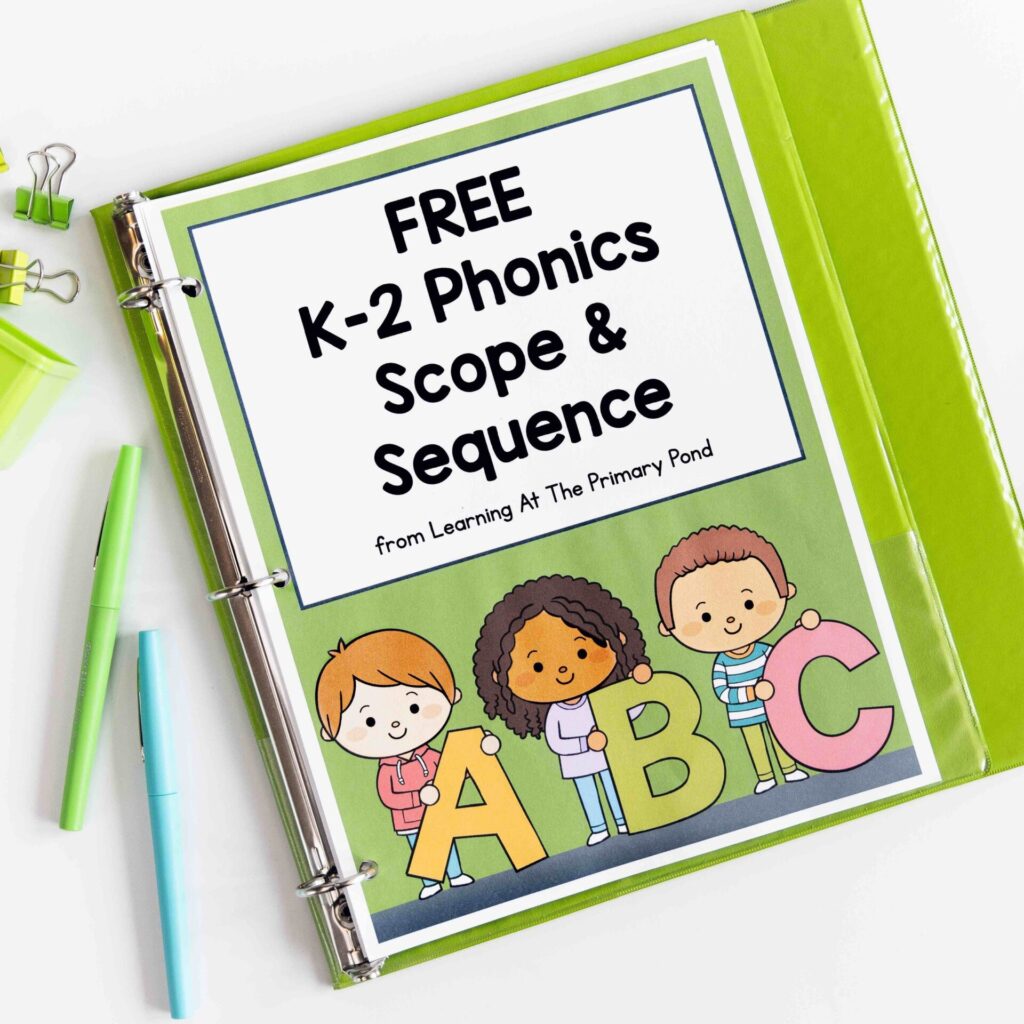
Principle #2: Phonics instruction should take place OUT of context (i.e. phonics-focused lessons), as well as IN the context of real reading and writing activities.
- When you are reading and writing with students, this is a great time to discuss and teach them about words. BUT this in-context practice is not sufficient.
- Students need dedicated instruction and a specific time in the school day to learn about letters and words.
- Learning phonics and spelling is part of becoming a good reader. When students read, they learn how to spell words. When students learn to spell words, this helps them with their reading.
- Even when we have a dedicated phonics or word study time, it’s still important to show students how to apply those concepts and notice words in context. Shared reading is a great opportunity to discuss letters and words, because students can see the text clearly. But discussions don’t have to be lengthy, especially if your lesson has a different focus. For example, if you come across a word with the short a sound and many students have been studying it, you might point to the word and say, “This word has a short a sound, doesn’t it? How do we say that letter sound? (/a/) Do you see any other short a words on this page?” (This is just one example – there are many more ways to help students notice and apply phonics learning in context.)
- Students’ independent work can be a combination of out-of-context and in-context activities. Students may be reading and sorting words, but they should also have a chance to find words with that specific pattern in real texts, and even their own writing.
- Here’s a good quote from Words Their Way: “The best way to develop fast and accurate recognition and production of words is to engage in meaningful reading and writing, and to have multiple opportunities to examine those same words and their features in and out of context” (Bear, Invernizzi, Templeton, & Johnston, p. 5).
Principle #3: Phonics knowledge is developmental. Students may develop at different rates, but they generally follow the same trajectory or sequence of learning.
- When kids are learning to spell in English, they typically learn to master letter sounds and word patterns in a predictable order (beginning with initial consonants, then final consonants, then short vowels, digraphs, blends, long vowels, etc.).
- Even when students have learning delays or disabilities, their progress still follows this predictable order – they just move through the developmental stages more slowly.
Principle #4: In order to be most effective, phonics instruction needs to be differentiated, so that it matches the specific level of the learners. This includes beginning letter sound instruction.
- Figuring out our students’ levels starts with a good assessment.
- A spelling inventory is a great way to assess students’ phonics and spelling knowledge. In a spelling inventory, you have students spell various words, and the words increase in difficulty. Then, you analyze their work to see what word features they have mastered and what features they are still working on.
- Words Their Way has several spelling inventories that I highly recommend. Other options include the Kindergarten Spelling Inventory, McGuffey Spelling Inventory, and Viise’s Word Feature Inventory (search for these online).
- Once we analyze students’ spelling, we can group students based on their abilities and differentiate our instruction for maximum results: “When students are taught at their instructional levels in spelling…they will make more progress than with materials that are too difficult for them” (Morris, Blanton, Blanton, Nowacek, and Perney, 1995, cited on p. 35 of Words Their Way, Bear, Invernizzi, Templeton, & Johnston).
- If you’ve heard of Vygotsky’s Zone of Proximal Development, that is exactly what we want to target with our word study instruction. We want to teach our students to master word features that they are currently “using but confusing” (Bear, Invernizzi, Templeton, & Johnston, 2015). For example, if a child is attempting to spell “bike” by writing “biik,” she is trying to use a long vowel spelling pattern. This might be a concept that she is ready to learn next.
- Although students may have a wide range of abilities, it’s best to teach phonics or word work in small groups: “Small group instruction…has been demonstrated to be more effective than whole-class or even one-to-one instruction in supporting young children’s early literacy development (Connor et al., 2006; Ehri et al., 2001)” (Piasta, 2014).
Even if students are at slightly different stages of development, it’s much more practical to have 3 or 4 groups than it is to have 10 groups. - Because students enter school with varying levels of letter knowledge, the principle of differentiation applies to letter sound learning, too. “Teachers get the best results when differentiating small-group instruction in response to the students’ existing alphabet knowledge” (Stahl, 2014, p. 262).
- When it comes to letter sound learning, I do like to (quickly) cover each letter in a whole group setting at the beginning of Kindergarten. At this point in the school year, the kids aren’t ready to do a ton of independent work. Once I’ve covered all of the letters (several each week) with the entire group, then follow-up instruction takes place in small groups.
I’ll share more ideas about organizing small group instruction in an upcoming post!
Principle #5: When working with a class of students who are learning their letters, it’s more effective to cover letters quickly (and loop back for review) than it is to teach one letter each week.
- Multiple studies have shown that students learn letters more quickly when taught a letter a day instead of a letter each week. (My own preference is to do 3-4 letters per week.)
- Once students have been exposed to all letters, you can then loop back and review. I like to do this review in a small group setting (see Principle #4).
- Use assessment data to group students for alphabet / letter sound instruction. The groups may not be 100% perfect matches, but you will still be able to target your instruction much better than if you relied only on whole-class lessons.
If you’re in need of a FREE resource for multisensory phonics centers that work on alphabet letters, click here for that freebie!
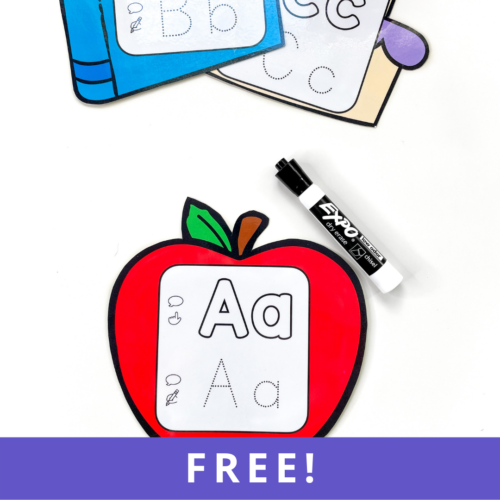
Principle #6: Students need to be taught to generalize spelling patterns.
- Traditional spelling tests (like the ones I took growing up!) have students memorize specific words. And students often forget those words immediately after the spelling test is over! It’s more effective to focus on word features or patterns that students can use to read and spell many different words. I think of this as learning about words as opposed to just learning WORDS.
- Although you may designate a set of words that students are working on for a week, it’s also important to have them practice using those spelling pattern(s) to read and write new, additional words.
Principle #7: Word study activities that emphasize PATTERNS rather than COPYING are most effective.
- There are many exceptions in the English language, but there are also many patterns. According to Blevins (2017), 84-87% of English words follow consistent sound-spelling patterns. And the human brain loves patterns! We can capitalize upon this by designing activities that focus on word pattern learning and application, rather than rote copying.
- For example, an activity like rainbow writing words is less effective than an activity where students have to sort and write words into categories based upon their features. The second activity requires more thinking, and therefore increases the chance that students are attending to the word features and learning the words, too!
- A good quote from Words Their Way: “There are many long-standing activities associated with spelling such as writing words five times, using them in alphabetical order, and copying definitions from the dictionary. Assignments like these do not fulfill the purpose of spelling instruction, which is to not only learn the spellings of particular words but also to understand generalizations about the spelling system itself and to cultivate a curiosity about words. Writing a word five times is a rote, meaningless, and ineffective activity (Templeton & Morris, 2000), whereas writing words into categories requires recognizing common spelling features and using judgment and critical thinking. Writing words in alphabetical order may teach alphabetization, but it will not teach anything about spelling patterns” (Bear, Invernizzi, Templeton, & Johnston, 2015).
Principle #8: Word study activities should be completed with words that students can already read.
- When students move beyond letter sounds and are working with words, they should practice phonics and spelling with words that they can already read. Otherwise, they end up not reading the words as they work independently. Activities then become rote and less meaningful.
- If you use word sorts, simply discard words that students can’t yet read. You can always put them back in in the future.
Conclusions
Phew, that was a lot! Thanks for hanging with me! 🙂
Did you read anything in here that really resonated with you? Do you plan to make any changes to your classroom instruction? Let me know in a comment!
As I wrote at the beginning of this post, I’ll be sharing ideas, activities, and freebies for phonics instruction and word work over the next few weeks. Check back each Saturday for a new post! Happy teaching!
Bibliography
Bear, D. R., Invernizzi, M., Templeton, S., & Johnston, F. (2015). Words Their Way: Word Study for Phonics, Vocabulary, and Spelling Instruction (6th ed.). Pearson.
Blevins, W. (2017). A Fresh Look at Phonics, Grades K-2. Thousand Oaks, CA: Corwin.
Daffern, T. (2017). What Happens When a Teacher Uses Metalanguage to Teach Spelling? The Reading Teacher, 70(4), 423–434.
Dahl, K. L., Scharer, P. L., Lawson, L. L., & Grogan, P. R. (2001). Rethinking Phonics. Portsmouth, NH: Heinemann.
Ganske, K. (2016). SAIL: A Framework for Promoting Next-Generation Word Study. The Reading Teacher, 70(3), 337–346.
Morrow, L. M., & Gambrell, L. B. (Eds.). (2011). Best Practices in Literacy Instruction, Fourth Edition. New York, NY: Guilford Press.
Piasta, Shayne B. 2014. “Moving to Assessment-Guided Differentiated Instruction to Support Young Children’s Alphabet Knowledge.” The Reading Teacher 68 (3): 202-211.
Reutzel, D. R.. (2015). Early Literacy Research: Findings Primary-Grade Teachers Will Want to Know. The Reading Teacher, 69(1), 14–24.
Stahl, K. K. (2014). New insights about letter learning. Reading Teacher, 68(4), 261-265.

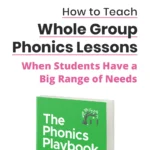
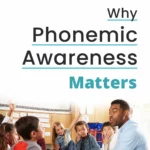
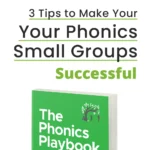

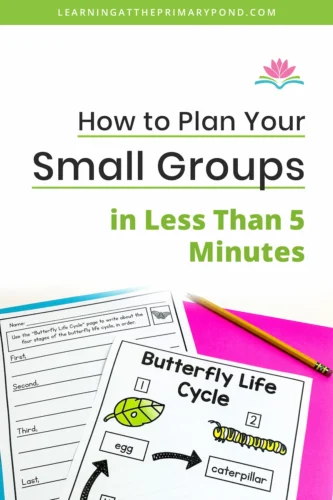







Along with your English scope and sequence could you recommend a Spanish scope and sequence?
Hey! This post might help with the Spanish side of things: https://learningattheprimarypond.com/blog/how-i-teach-beginning-spanish-phonics/
Alison
Thanks! This reiterated to me what I’ve already believed and tried to do. I struggle with the implementation and logistics of the differentiated groups and time to plan specific activities for each level. Looking forward to your tips.
Hey Bev! I’m glad this was a good review – check back this coming Saturday for more about small group logistics. 🙂
Alison
Thanks Alison I appreciate your hard work and sharing so much with other teachers!
You’re so welcome, April! Thanks for reading!!
Alison
Some great reminders and some great new tips! Really appreciate this post! Thanks!
Glad it was helpful, Kate! Thanks for reading and commenting!
Alison
All great information. Thank you. I’m beginning to change my approach during my reading block and this is definitely food for thought.
So glad this was helpful, Cheryl!
Alison
A super article. What resonated with me was the point you made about patterns.
Thank you so much – glad this resonated with you!
Alison
Thank you Alison! Every suggestion and resource that you have given me in reading and writing has worked beautifully in my classroom, and I’m SO excited to be learning Phonics/word work instruction from you!! I’ve been struggling for several years about the very questions you have cited in this post – I will be reading everything and getting ready to ramp up my phonics instruction with my 2nd graders next year. Thank you so much for sharing this things with us!!!
You’re so welcome, Jana! Thank you for reading and for your sweet comment!!
Alison
Hi Alison! Thanks so much for all you do! I’m a new teacher and I’ve read so much and gathered so much material prior to actually beginning to teach and a lot of it was based on the teachings/researched philosophies of Blevins. This is only because my graduate program required her literature. I have since found that following the guidelines and requirements of my district and/or administrators makes it impossible to implement targeted instruction in phonics and writing. Please help me figure out a way to navigate this area so that I can help my students be as successful as… Read more »
Hey Renea! I have been in the same situation with tricky district requirements. Please feel free to email me if I can be of further help!
Alison
This as a fantastic review. Thank you for the references.
Thank you. I knew this information but having a refresher is always welcome. I am really looking forward to your future posts about making groups and what to teach in each group.
I couldn’t agree more about the need to use and constantly revise spelling patterns! I say to my class that we are not learning spelling – we are learning HOW to spell!
So true, Penny!!!!
Alison
Allison,
I always appreciate your dedication to helping us all be the best teachers we can be. You remind us of so many things we should be doing to help our students.
Thanks,
Lisa
Thanks, Lisa – so glad it’s helpful!! I appreciate your sweet comment!
Alison
Great read! I like your point about students not reading the words and the activities becoming rote and meaningless. Thank you for your dedication to teachers and students.
I love how this information was so thorough and made perfect sense. I too struggle with the logistics or getting my groups rolling and organizing sequential activities for each group. Looking forward to more guidance! Thanks so much!
Hi Alison, This is interesting. Thanks for sharing. It’s so hard to choose spelling approaches: each one of the programs you mentioned, and all the ones I’ve seen in Australia, are all written by highly knowledgable people with PhDs and extensive experience in literacy. They also have different philosophies and ideas that they are keen to push, so it’s hard to filter out what is really going to work, and what won’t. We did a whole school PD (Professional Development) day last week on spelling, with a lady called Michelle Hutchinson who has developed a program called SMART spelling. I’ve… Read more »
Hey Michaela! Thank you for sharing this – I just love learning about different ways of teaching phonics! I’m curious to hear how you like the approach throughout the school year!
Alison
Michaela,
Were you happy using SMART for the rest of the school year?
Yes, Yes, Thank you. Have ordered a copy of the book ‘Words their Way’ as am interested in assessment. Perfect timing, having started with an all class phonics program that doesn’t seem enough I am looking for new ideas.
Awesome – I hope you love the book! It’s a lot to read through at first, but 110% worth it!
Alison
Great article! Patterns! This is so important! That is why we need to adapt things like “Rainbow Write” to color coding the “patterns” or “pattern” only instead of randomly coloring each letter with a different color. Have the students use pencil for the rest of the word. I actually do the “sort and write words into categories” every week with their new list of words. I use a site called “Free Printable Flashcard Maker” to quickly make “sort cards and generate title pattern cards” to go with our Pearson Reading Street curriculum. I differentiate by using Words Their Way Sorts… Read more »
That’s awesome Wendy – I have not heard of that site! Thank you for sharing!!
Alison
I absolutely learned a lot! Thank you for sharing your ideas!
Thanks so much Alison! Do you use a specific teaching order for introducing letters in Kindergarten?
Hey Emily! I have pieced things together here and there, but Wiley Blevins has a sequence in his book A Fresh Look at Phonics that I plan to follow from now on, more or less. The book is on Amazon if you’re interested! 🙂
Alison
Allison,
I love your blog. I love everything you suggest!! I have been struggling with why my first graders are not making the growth needed this year and I believe it is because I am not dedicating enough time to word study and direct explicit phonics instruction. I am big fan of Wiley Blevins and just re-read his book I own. I have been using Jan Richardson’s Next Step in Guided Reading template and am going to include word study daily (the templates do not do daily word study). Anyways, thanks again for helping me reach my students!
Hey Christina! Thanks so much for reading! Those sound like awesome next steps for your firsties – and those are both such good books. Let me know how it goes!
Alison
I stumbled upon your blog when looking for a resource for a class I am taking! You have great ideas, and I just sent the link to your blog to a couple of my colleagues. I think your ideas will be so helpful to us as we plan out next school year. Thanks!
Hey Karen! Thank you so much – I’m glad the posts are helpful to you! Thanks for reading!! 🙂
Alison
Hi!
I very much agree with and appreciate all of the best practices you shared. I might have missed this, but didn’t notice any mention of phonological awareness (more of a focus on letter and sound identification and then spelling patterns). I’m wondering when and where in your schedule you suggest teaching phonological awareness (e.g., rhyming and syllable identification in kinder, phonemic segmentation and blending, phoneme deletion, etc, later on).
Thanks!
Hey Casey! I usually do those activities as transitions, between one activity and the next. So I sneak them in all throughout the day. I try to involve movement when I can, too! 🙂
Alison
Love this so much! I was wondering if you have an order or sequential list of the word patterns that you teach?
Hey Rhiannon! I have used Words Their Way in the past for a sequence. 🙂
Alison
Alison – I appreciated all of your insight on teaching phonics. I am enrolled in a reading class and have just completed tutoring sessions with a struggling first grade reader. He is very aware of all letter sounds and has a moderate level of decoding skills of CVC words. We have been working on that skill and on consonant blends. After a few activities it was clear that he is struggling with consonant blends that end in ‘r’. He had mastered the blends that ended in harder sounds like ‘k’ or ‘t’. What type of activities would you recommend that… Read more »
Hi Jennifer! With the r-blends, could it be an issue of articulation difficulties or phonological difficulties? Can he isolate the two sounds if you say a blend out loud? Feel free to email me so we can discuss further. 🙂
Alison
Hi Alison!
Thanks for writing this post! I always come to you when I am lacking inspiration or ideas. This particular post helped me refocus my phonics teaching and get ready for the week.
I’m so glad, Taylor!! Thanks for reading!
Alison
Your posts are so helpful! We have been using words their way in our first grade classrooms and now will be getting a phonics curriculum (I think Fundations). Should we discontinue WTW or would it make sense to do both? Thanks!
Hey Randi! I haven’t worked extensively with Fundations (although I use the “sister” program, Wilson) but I do think that it makes sense to do both – your foundational phonics instruction AND word sorts. I think they’ll complement each other nicely, although you’ll probably have to spend less time on WTW. 🙂
Alison
Regarding Principle #7 – what (best) practice activities do you recommend for students to do independently to practice their word study features? Thank you for your time.
Hi Amy! You probably already use word sorts, but those are a big one I use! I also do word hunts where kids look for words with the target features in the context of real texts. For other activities and games, I look for things that have the kids reading the words and taking note of their patterns. I’ve been creating these Boom learning cards to make sure my kids are really able to read the words while they’re practicing the phonics patterns: https://www.teacherspayteachers.com/Store/Learning-At-The-Primary-Pond-Alison/Category/Boom-Learning-Cards-323256
I hope this helps!
Alison
Hi!
What sequence of letters would you recommend when teaching letter sounds/names?
Hi Reese! While there’s no one “correct” sequence for teaching the letters (and I’ve used different sequences over the years), I do have a free guide that has a suggested scope and sequence: https://lead.learningattheprimarypond.com/free-guide-to-teaching-phonics-in-Kindergarten
I hope this helps!
Alison
Thank you for all this info. Would love to hear more on your small group lessons for kindergarten from beginning letter Identification and sounds with whole group to small group and then after assessments what to intro and how.
Hi Maureen! Thanks for the post ideas – that’s actually in the works! 🙂
Alison
Hi! I’ve been reading your blog and reevaluating my ela block in my 2nd grade classroom. My school uses the Journeys curriculum and I’m not sure how to implement some of the ideas that you’re presenting with a 5 day week structured schedule like Journeys. I would really appreciate any further help or advice. Thanks!
Hi Ashley! I haven’t used Journeys myself, but maybe this post could help with ideas for your overall schedule: https://learningattheprimarypond.com/blog/fitting-it-all-in-how-to-schedule-a-balanced-literacy-block-for-second-grade/
Alison
I’m really enjoying your blog. I teach high school 11th grade but am working on my reading and literacy credential. Never having taught the little ones how to read, I find your blog very informative and helpful. Thank you soooo much.
BTW, the textbooks you mentioned here…those are the ones CSU uses in their MA program. Everything you said…that’s what I am learning. Good job!!!!
I’m so glad it’s been helpful, Carol! Thanks for reading!!
Alison